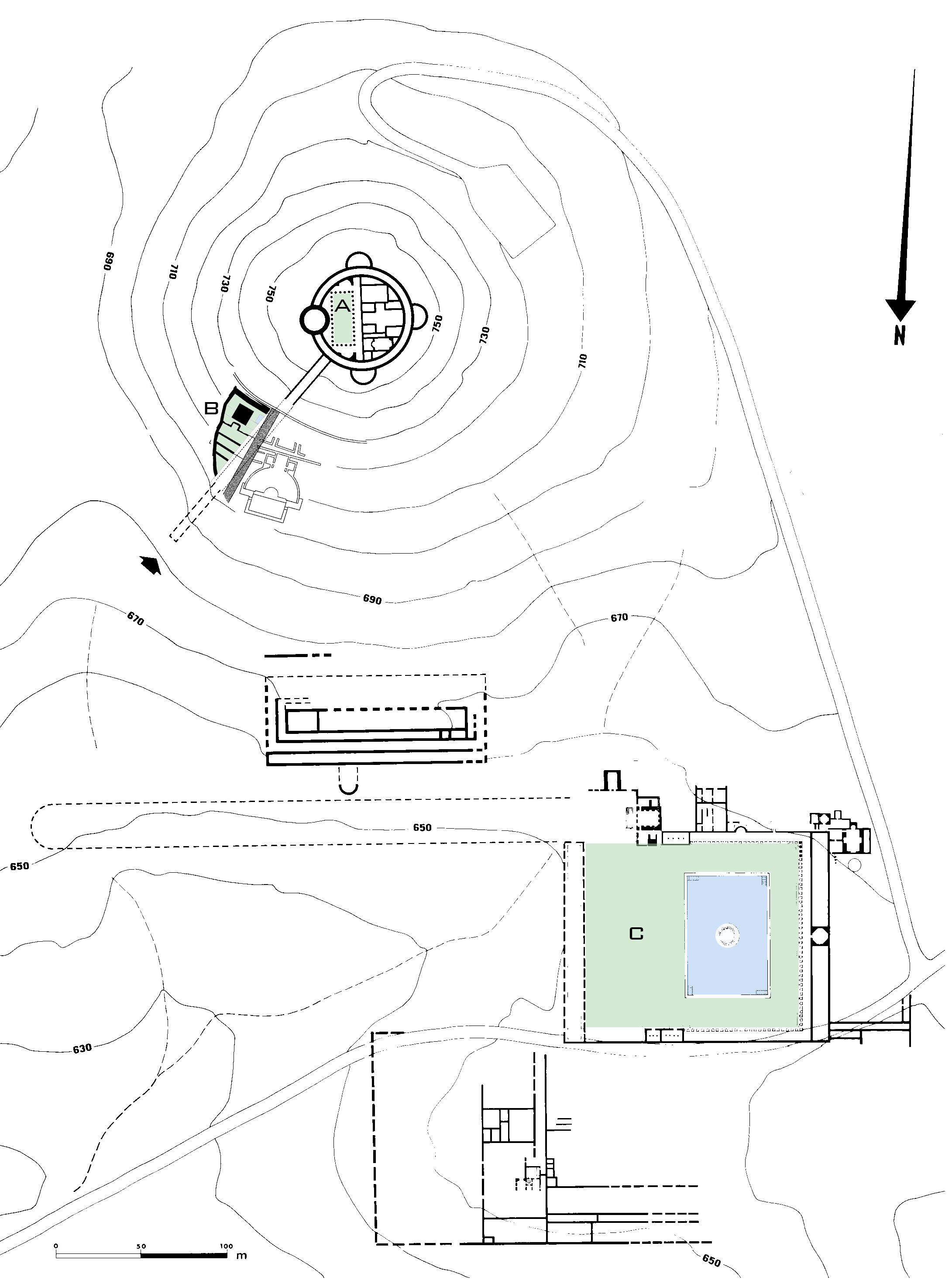Herodium Herod’s Tomb Garden
Province
Judaea
Iudaea (province) (Pleiades)
Province Description
Judaea, the Roman province, included parts of the areas of the Hasmonean and Herodian kingdoms, notably Biblical Judah, Samaria, and Edom. Its capital was Caesarea Maritima. Roman influence in the region began in 63 CE, when the Roman general Pompey the Great conquered Syria from Mithridates of Pontus, besieged Jerusalem, and captured the Second Temple; he appointed Hyrcanus, one of the two Hasmonean brothers fighting for kingship, as ethnarch of Judaea. Later, Julius Caesar appointed Antipater, the father of Herod, as Judaea's first Roman Procurator. Later these ties allowed Herod to seek backing from Rome against the Hasmoneans in 40 BCE, when the Senate recognized him as “king of the Jews.” His territories came to include the regions of Galilee, Gaulanitis (the Golan),Peraea and the Decapolis, and Augustus later granted him the coastal cities, Batanaea, Auranitis, and Trachonitis. Herod balanced his allegiance to Rome with the independence of his kingdom, often employing architectural projects to express his ambitions and control of nature to express his capacity to rule . His many palaces, placed strategically around the kingdom, feature dramatically designed landscapes and gardens. Upon his death, his son and heir Archelaus was unable to maintain order and the major part of Judaea was annexed to Syria in 6 CE, with its own prefect, while two other sons of Herod, Philip and Antipas, received territories as tetrarchs. By the time of Trajan, Judea was reduced in size and many of the Herodian palaces abandoned, preserving them over the millennia for archaeologists. Hadrian renamed the province After the Bar Kochba revolts (132-135)Hadrian renamed the province Syria Palaestina, erasing the name of Judaea.
The geography of Judaea comprises a wide variety of biomes, from richly watered plains of the Galilee and the Jordan, to the semi-arid Judean Hills, the humid, fertile coastal plain of the Mediterranean, and the deserts of the Dead Sea valley and the Negev. The period for which we have the richest evidence of a garden culture in this region is during the reign of Herod the Great. An allied king of Rome, Herod’s relationships with Mark Antony, Cleopatra, Augustus, and Marcus Agrippa and other officials ave been preserved in the texts of Flavius Josephus. These constitute a rare record of interactions between Rome and its territories, and provide a valuable context for understanding the trends of design in the early imperial period. The proximity of Judaea to Alexandria, whose palaces and gardens lie beneath the modern city and its harbors, may also provide a suggestion of the late Hellenistic garden culture that Romans emulated. Evidence of gardens in the Hasmonean winter palaces at Jericho and the palace identified as that of Hyracanus the Tobiad at 'Iraq al-Amir on the other side of the Jordan Valley provide rare cases where texts can illuminate archaeological evidence. These gardens require further investigation and both are threatened by local development.
Location
Location Description
Herodium
Herod the Great’s primary residence and burial place appears to have been this large palace complex 15 km southwest of Jerusalem. Here his court was within easy reach of the city, and on clear days the palace and the Mt. of Olives are visible in both directions. Herodium was an entirely new administrative and residential complex, commemorating his military victory over Antigonus for control of Jerusalem in 40 BCE. Herodium was begun c. 23-20 BC and offered a Herod a range of facilities in which he could perhaps live and conduct business more freely here than in Jerusalem. (Jewish Antiquities, XV, 323-325) The palace has two primary residential areas: the fortified palace atop a natural, but raised hilltop; and an unfortified palace that spans a gentle valley below. (Fig. 1) (Josephus Jewish War I, 419-421; Jewish Antiquities, XV, 323-325).
Garden
Royal Garden
Keywords
Garden Description
Herod’s Tomb Garden
In 2005, Netzer’s team found the long-sought tomb of Herod, positioned on a terrace constructed into the slope of the artificial hill. This terrace was constructed of chipped stone and construction debris, largely the light limestone of the area. To the front and sides of the tomb, a layer of rich brown loam, similar to that found in the other garden areas, clearly indicated a garden. (Fig. 4) A small pool with lead piping was found to the side of the terrace. Although the lead pipes had been robbed, the pool evidently watered the terraced gardens (fig 1B, 2, and 3)
Plans

Fig. 1:Plan of the complex at Herodium showing the Fortress Palace with its small peristyle garden (A), the Tomb Garden (B) and the Lower Palace with its central pool and cultivated grounds (C) (Yaniv Korman after Netzer)
Dates
15 BCE - 60 CE
Bibliography
- E. Netzer, “Greater Herodium” in Qedem, Monographs of the Institute of Archaeology, The Hebrew University of Jerusalem 13, 1981 (worldcat)
- E. Netzer The Palaces of the Hasmoneans and Herod the Great, Jerusalem: The Israel Exploration Society, 1999, 98-107 (worldcat)
- I. Nielsen, Inge, Hellenistic Palaces, 1994, 201-203. (worldcat)
- R. Porat, R. Chachy, and Y. Kalman. "Herodium I: Herod’s Tomb Precinct, Final Reports of the 1972-2010 Excavations Directed by Ehud Netzer." Jerusalem: Israel Exploration Society (2015). worldcat
- D. Langgut, M. Cavanagh , R. Evyasaf, Y. Korman, R. Porat, G. Stiebel., K. Gleason. "The reconstruction of Herod the Great’s palatial gardens in Herodium: a botanical perspective", In: Chachy R, Kalman Y, and Porat R (eds.), "Lower Herodium," in HERODIUM II; Final Reports of the 1972-2010 Excavations Directed by Ehud Netzer, Jerusalem. In press
Pleiades ID
TGN ID
Contributor
Publication date
21 Apr 2021